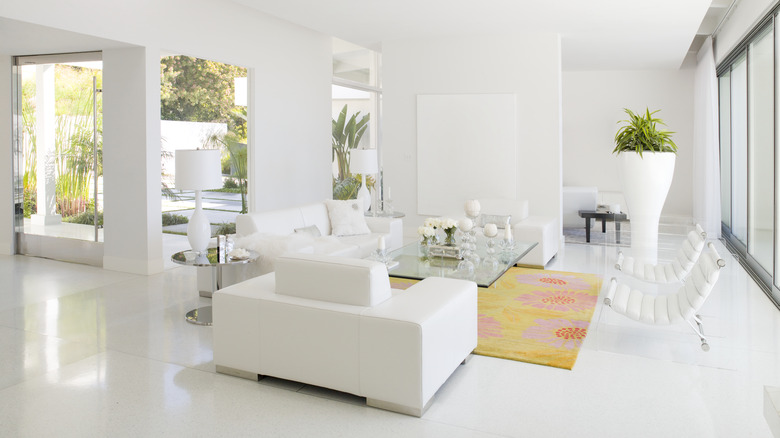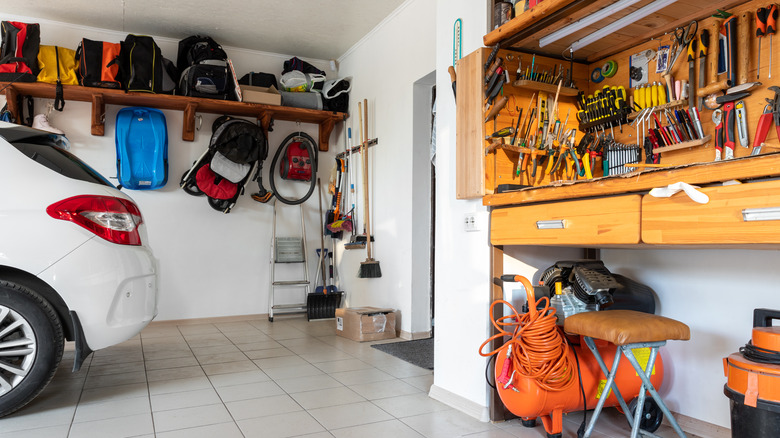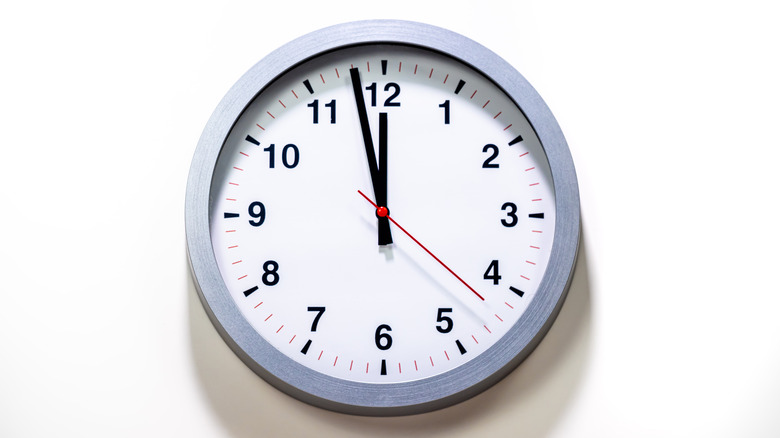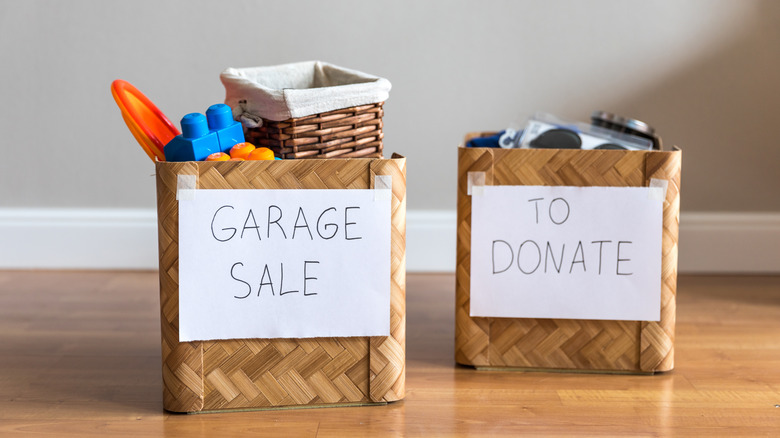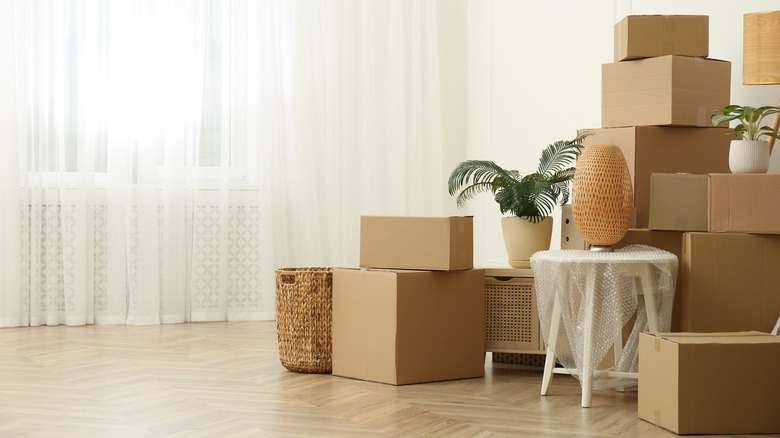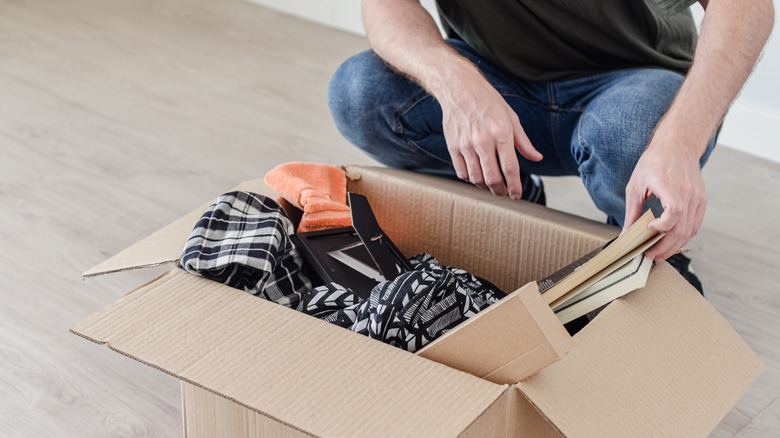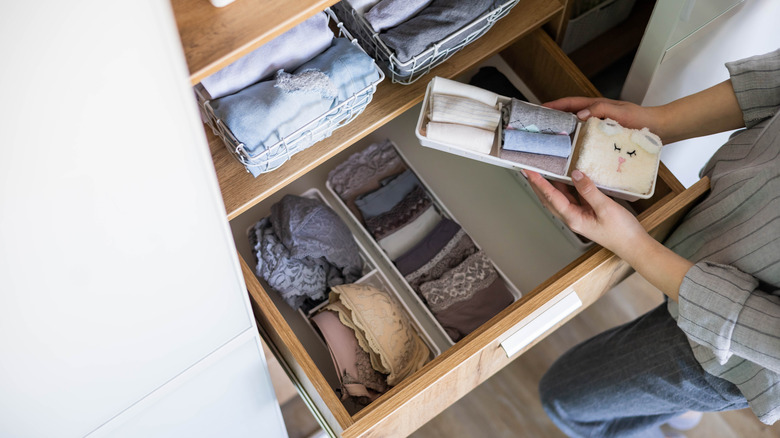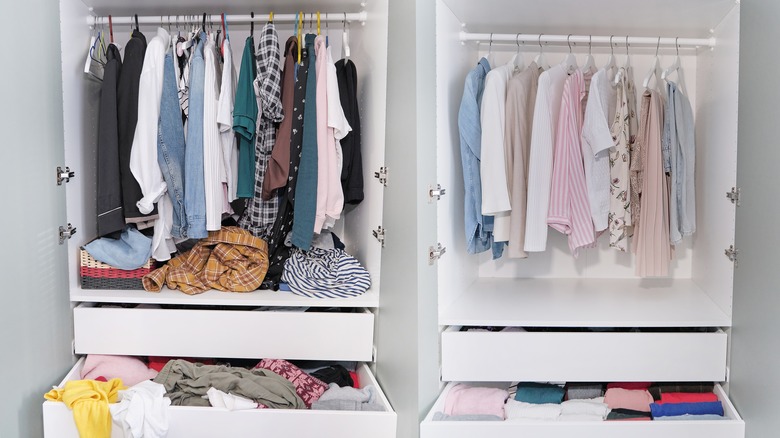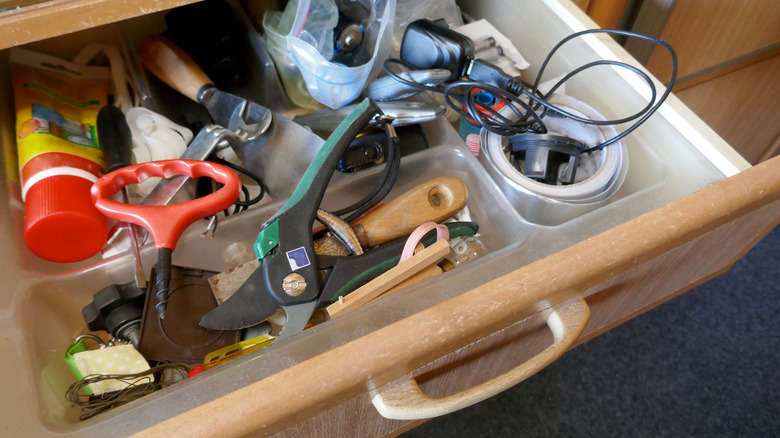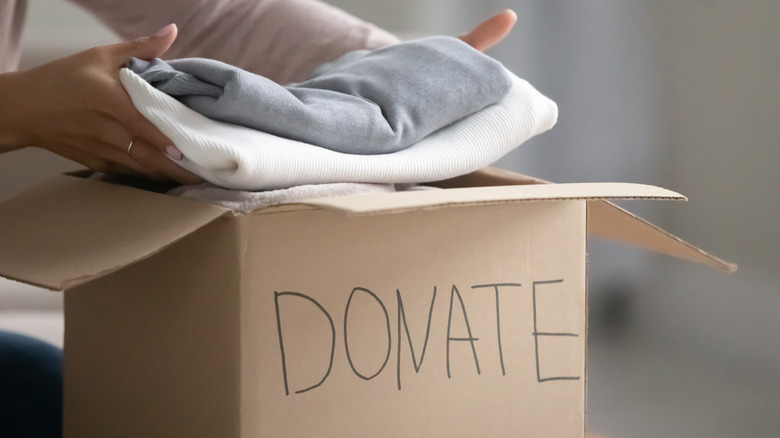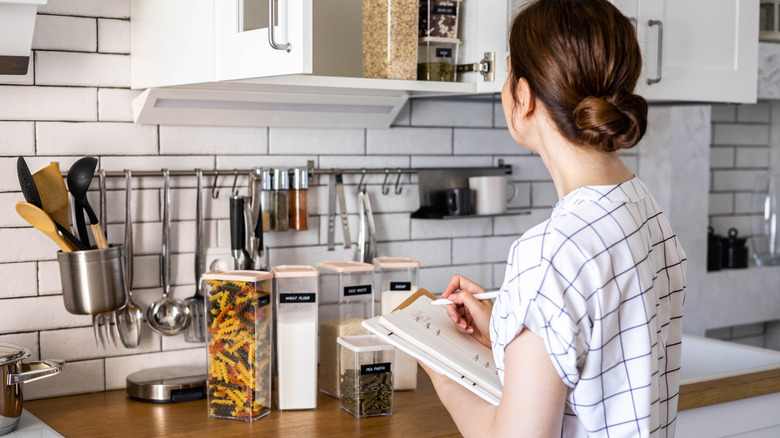Best Strategies For Decluttering Your Home
We may receive a commission on purchases made from links.
Clutter has a way of collecting in the homes of even the most diligent housekeepers. If we forget to declutter or fail to do so at regular intervals, it can take over the spaces that we might otherwise use for entertaining, relaxing, or working on projects. On top of that, clutter becomes an eyesore that detracts from a pleasant home environment. According to VeryWell Mind, a cluttered living space makes it difficult to focus and may even worsen feelings of depression.
For these reasons, you might be ready to embark on a decluttering project. Decluttering your home is more than a lofty goal to create an attractive living space. It's a pathway forward to reduced stress and better mental health. Psychology Today notes that when we clean and organize the possessions in our homes, we gain mental clarity and lessen our feelings of anxiety. There's an additional advantage if you share your home with family members or roommates: the act of decluttering can help to improve frayed relationships. Fortunately, experts offer strategies for decluttering your home in the most thorough and effective ways.
Start with a vision and a plan
Before you begin work on the decluttering tasks, it's helpful to envision how you want your living space to look. Try to imagine the cleared tabletops and the neatly arranged and stored possessions that will grace your home after the decluttering project is finished. Then, devise a plan of action that will help you realize your goal of creating a calm and organized environment. Abundant Life with Less states that if you develop a "minimalist mindset" before starting the project, you'll be emotionally equipped to purge unnecessary items from your home.
According to The Order Expert, it's wise to map out your project by dividing it into broad categories. Then, under each category, create a list of tasks. For example, you might designate your kitchen as a decluttering category. Next, you'll devise a plan to accomplish the necessary tasks in the kitchen. These might include decluttering your dishes, utensils, pots and pans, small appliances, and junk drawer. Completing each task brings you one step closer to a decluttered kitchen. When you've completed the kitchen category, it's time to move on to the next step in your plan.
Set time limits
While you're developing the plan for decluttering your home, set time limits on the overall project as well as each of the tasks that will get you to the finish line. Give yourself a long-term time limit for organizing your living and storage spaces. For example, you may determine to complete the entire job within six weeks. Then, give yourself an appropriate time limit for each task that you'll tackle along the way. Without designated time limits, it's easy to procrastinate, and the vision of a decluttered home environment may never become a reality. Forbes explains that creating a project timeline helps you to stay organized, meet deadlines, and accomplish your goals.
Don't be discouraged by thinking that you must devote long hours of uninterrupted time to your decluttering project. Many people find it helpful to structure their decluttering tasks in short bursts of a few minutes each. According to Becoming Minimalist, you can define a space and declutter it in as little as five minutes. Five minutes is plenty of time to clear off a desktop, sort a pile of books, or declutter a junk drawer. If you can string together a quantity of 5-minute decluttering mini-projects, you'll be on your way to establishing a more serene home environment.
Create personal guidelines and make decisions
Many people experience a kind of paralysis when it comes to decluttering. They can't decide which items to keep and which items they should purge from their homes. Therefore, they can't muster the mental energy to start the decluttering project. The best way to counteract the paralysis of indecision is to set guidelines and make decisions up front. For example, before you begin decluttering your clothes closet, you might determine that you will not keep any items that require dry cleaning (via Simply + Fiercely). Then, when you come across a dry-clean-only garment, you know to get rid of it. Once you have parameters like this set, it's easier to decide what to keep and what to get rid of.
According to 365 Less Things, you can set personal guidelines for decluttering by asking yourself a series of questions about each item in your home. Queries include whether the item is in functional condition, whether you've needed it in the past months or years, and whether you have multiples of the same item. If your answer to questions regarding the value of an item is "yes," then it should be stored or displayed in your well-organized home. On the other hand, if you cannot think of why the item has value, then it should be donated, sold, recycled, or thrown away. If you share your home with others, be sure to include them in the decision-making process. A family member may find value in an object that you view as trash.
Clear the room
One way to declutter is to start by clearing everything out of a room. This gives you a blank slate to work in and an opportunity to thoroughly clean the space. Then, put back only those objects that you consider to be necessary or desirable. Get rid of the rest of the stuff. You can decide which items you will donate, sell, or throw away. The things that you keep will have greater meaning to you, and you'll organize them in a fresh, clean, living area.
The Minimalists suggest putting a fun spin on clearing a room or your entire home. Invite a friend or a few friends to a "Packing Party." Order pizza and have plenty of snacks and beverages on hand. Ask your friends to help you pack up all your stuff in boxes. It's the type of event you'd host if you were moving to a new home. After you've packed away all your possessions, remove items from the boxes only as you need them. After about a month, you'll realize that you don't need those objects that remain in the packed boxes. Then, it's time to get rid of the excess stuff and enjoy your pared-down, minimalist lifestyle.
Use the four-box method
The four-box method is a practical approach to decluttering. It helps you make decisions about what to do with all your stuff. To employ this method, you'll need to acquire plastic bins or cardboard boxes. Designate four of your boxes with the labels: "Keep, Store, Give Away, and Throw Away" (via Easy Storage). Then, as you handle each item in your decluttering area, simply place it in the appropriate box. Of course, you can adapt this method to your personal needs. For example, you might designate separate boxes for throwing away some items and recycling others. Additionally, you may want to separate the possessions that you'll give away to family members from the items that you'll donate to a charity shop. Use as many boxes as you need with a label on each one.
CubeSmart recommends that you begin the decluttering project with large items such as furniture. Exercise equipment, old appliances, and large decor items fit into this category. Once you've cleared out the large items that need to go, you'll have more space to work in. Then, move on to the four-box method for categorizing the smaller items that remain in the space. Get rid of the things that you decided to throw away, give away, or recycle. Clean and repair the items that you're keeping, and then store or display them in your newly organized home.
Embrace the KonMari method
Japanese cleaning and organizing expert Marie Kondo achieved international fame with her book "The Life-Changing Magic of Tidying Up." You may want to base your approach to decluttering on the principles of the KonMari method. According to Kondo, decluttering is most effective when you strategize the project by categories of possessions, rather than by rooms. For example, you gather all of your clothing from closets and dresser drawers all around your home. Then, you handle each piece of clothing to determine if it has value and is worth keeping. The items you keep must be neatly folded or hung in a closet, and all other pieces of clothing are purged from your home. After decluttering and organizing your clothing, Kondo advises tackling your piles of books and papers. The next step is to declutter the miscellaneous items around your home, and the last step involves making decisions about which sentimental items to keep and organize.
This strategy emphasizes focusing on the things you want to keep instead of the junk that you want to discard. The KonMari method encourages us to keep only those objects that "spark joy" in our lives. She promotes the positive emotional effects of living in a well-organized, clutter-free home, surrounded by objects that we love.
Consider the 80/20 rule
Most of us wear 20 percent of our clothing 80 percent of the time. Extend this concept to additional items such as books, tools, small appliances, and more. You'll see how many things you can purge from your living space. Bella Organizing notes that many of our possessions go unused for long periods of time. Meanwhile, they take up space that could be cleared to produce a more tranquil domestic atmosphere. Therefore, observing the 80/20 rule provides a useful strategy and inspiration for decluttering our homes.
Basic Organization explains that the 80/20 rule is also known as the Pareto Principle, referring to Italian economist Vilfredo Pareto (1848-1923). In fact, it's not a rule but rather an observation. The principle evolved around Pareto's initial observations: 80 percent of your results come from 20 percent of your effort — the trick is figuring out which 20 percent is worthwhile. Economists, business experts, and organizers continue to apply the 80/20 rule to many situations. With this principle in mind, you can eliminate much of the clutter that takes up space in your home.
Apply the 20/20 rule
Decision-making is one of the primary difficulties in decluttering a home. Too often, we're not sure whether to get rid of an unused object or hang on to it because we might need it in the future. It makes sense to be frugal rather than tossing out useful items without due consideration. But indecision may result in a mounting collection of clutter that takes over your living space.
The Minimalists explain a helpful strategy for decluttering all those items that we keep "just in case." It's called the 20/20 rule. If you're hanging on to an object because you might need it in the distant future, consider whether you could replace it within 20 minutes for under $20.00. You probably will never need the unused items that take up space unnecessarily. But ask yourself if you ever need a particular item, could you drive to a store within 20 minutes of your home and replace it for less than $20.00? If the answer is "yes," then toss, recycle, or donate the item. Imagining the 20/20 scenario allows you to see the wisdom of letting go of the "just in case" objects that clutter your home.
Follow the Becker method
Joshua Becker is a minimalism expert and author of "The Minimalist Home." He advocates a room-by-room approach to clearing out your old stuff and creating a well-organized home that serves as a base for greater engagement in life's adventures. The Becker Method comprises an actionable, five-step plan for decluttering your home.
First, Becker advocates that you crystallize your reasons for wanting to decrease the number of possessions in your home. It's helpful to put your goals in writing. Next, the author encourages you to communicate openly with all members of the family and to involve them in the decluttering project. Then, Becker recommends starting in a room of your home that will be easy to declutter. This might be a living room or dining room. He warns against beginning the project in a storage area like the attic or garage where the pile of clutter might seem overwhelming.
The fourth step in Becker's method is to become aware of the rewards of living in your newly organized space. As you continue the room-by-room decluttering project, focus on how your daily home life is improving as each space becomes more peaceful and organized. The final step in this process is to return to your initial reasons for wanting to declutter. Becker suggests you assess and re-state your goals for minimizing your possessions, focusing on new, life-changing possibilities.
Engage with a friend in a 30-day challenge
Any difficult project becomes easier and more interesting if you can make it into a game. The Minimalists outline a fun way to work on decluttering your living space. Solicit a friend or family member to play the "30-day minimalism game" with you. On the first day of the month, each of you purges one item from your home. On the second day, you must get rid of two items. The third day sees three items donated or thrown away, and so on. The game will be easy in the beginning, but it will become more difficult as the month progresses. By the end of a month, both you and your game partner will have removed 465 unnecessary items from your respective living spaces. On the other hand, one of you may drop out before Day 30. The one who keeps the activity going longer is the winner.
When you're playing the game and purging items from your home, keep in mind that the objects can come from any category of possessions. These include kitchen utensils, towels, bed linens, clothing, books, games, and more. Becoming Minimalist offers a list of 101 things that you can declutter from your home. You might want to create a similar list for yourself as you launch into the 30-day minimalism game. Good luck!
Donate, sell, and recycle
Clearing items from your living space and deciding to get rid of them is an important first step. Next, you need a strategy for removing those items from your home in a responsible manner. Sometimes, we procrastinate on decluttering projects because we don't understand the most advantageous methods for donating, selling, and recycling our possessions. The New York Times suggests investigating the charitable organizations in your community that accept donations of gently used items. A few charity shops will even send a truck to your house for pick-up. If you're purging clothing, furniture, and other possessions that are almost like new, you can sell them for a bit of extra cash. Check out the consignment shops in your area, sell through an online marketplace website, or use a specialized app for selling your stuff. Of course, holding a garage sale is always an option.
If some of your clutter is too damaged to donate or sell, Neat Little Nest advocates recycling that trash as much as possible. This is usually accomplished through your local municipality with curbside pick-up or through a centralized drop-off location. Some of your old stuff may fall into the "hazardous waste" category. These items include old paint cans, motor oil, batteries, computer electronics, medicines, and more. Check with your local municipality to learn the process and the location for disposing of hazardous waste products in your area.
Keep horizontal surfaces cleared
Think about where clutter accumulates in your home. Things pile up on the flat surfaces of countertops, tabletops, shelves, and the floor. A viable strategy for conquering your clutter is to keep those horizontal surfaces cleared. According to Decluttering School, it's advantageous to spend some time analyzing the types of objects that pile up in problematic locations around your home. For example, if you tend to drop car keys, mail, and your purse on the kitchen counter, it means that your home is due for a mini-makeover in the entryway. There, you can create a dedicated shelf, table, or basket for dropping your stuff when you enter the home.
According to Forbes, you can avoid the clutter build-up on horizontal surfaces by creating vertical storage. Hang items on hooks attached to walls or doors. Pegboards, floating shelves, and wall-mounted filing systems provide vertical storage for a plethora of items. Of course, if you can invest in furniture with drawers and cabinet space with closed doors, you can keep your possessions neatly stored out of sight. The appearance of cleared horizontal surfaces will introduce a more serene vibe to your home.
Hire a pro
If the job of decluttering seems overwhelming, you might engage the services of a pro. You can find a trained and certified professional organizer to help you achieve your vision of a clutter-free home. Consult the National Association of Productivity and Organizing Professionals to find a pro in your area. On the website, you'll find a directory of professional organizers available for hire. In addition to offering the directory, NAPO offers online courses taught by professionals. Upon completion of a series of courses, participants can take a test to achieve licensure as a Certified Professional Organizer.
The KonMari method offers certification for professional consultants trained in the Japanese art of tidying, made famous by Marie Kondo. For initial certification, consultants must complete a series of courses, pass an exam, and submit reports on at least 30 hours of tidying in clients' homes. Then, the consultants pass through six levels of certification culminating in the "Certified Master" level. On the website, you can search for a certified KonMari consultant who is available for hire in your area.
